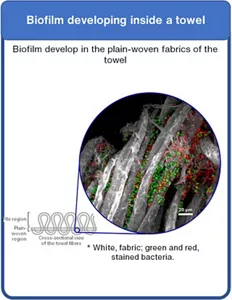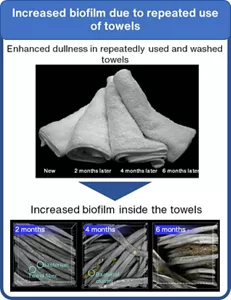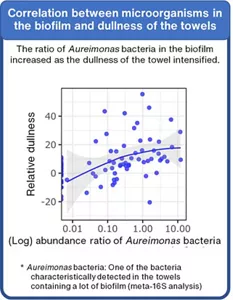Analysis of Microbial Clusters in Used Towels
Environmental Microorganisms
Microorganisms cover themselves with self-produced polysaccharides or proteins, and adhere themselves to a solid surface and form microbial clusters (biofilms) that cause many problems in our daily lives. So to develop microbial control techniques that solve such problems, Kao analyzes the state of the biofilms and the relationship between the biofilms and our daily problems.
Although it is widely known that microorganisms and their metabolic products on fibers are main causes of odor or dullness of clothes and other fabric products, the details of how such microorganisms stick themselves to the surface of routinely used towels have been unclear.
To find out how, we analyzed towels that had been repeatedly used and washed, and noted that biofilms were common not in loop-woven pile yarn on the surface of the towels but rather in the plain-woven fabrics in the deepest parts. The longer the towels had been used, the larger the biofilms became and the duller they became, suggesting that biofilms are difficult to wash out in the normal way.
Comprehensive analysis (meta-16S analysis) of the extracted DNA contained in the biofilms revealed bacteria different from those frequently found in T-shirts and other fabric products. Bacteria of Aureimonas species were commonly present, particularly in towels containing a lot of biofilms. The more frequently Aureimonas existed, the greater the changes in whiteness were compared with that of new towels (relative dullness).
We will continue to work on the development of microbial control technology to solve problems like this and help to improve everyday hygiene through microbial analyses.



Published article
H. Kato et al. Sci Rep. 13, 7611, 2023.
- Home
- Innovation
- Research & Development
- Fundamental Research
- Safety Science
- Analysis of Microbial Clusters in Used Towels
- Home
- Innovation
- Research & Development
- Fundamental Research
- Safety Science
- Analysis of Microbial Clusters in Used Towels
